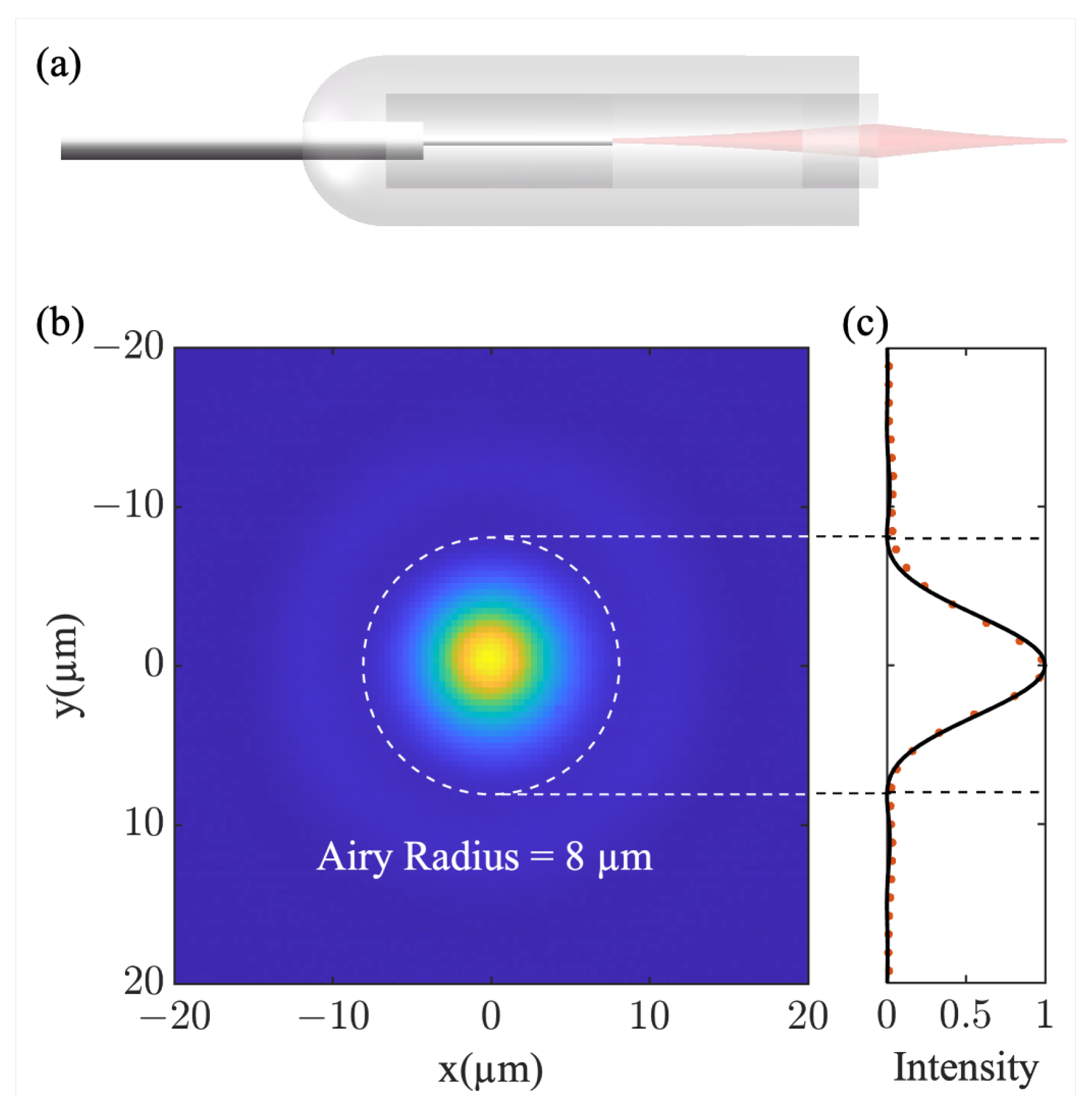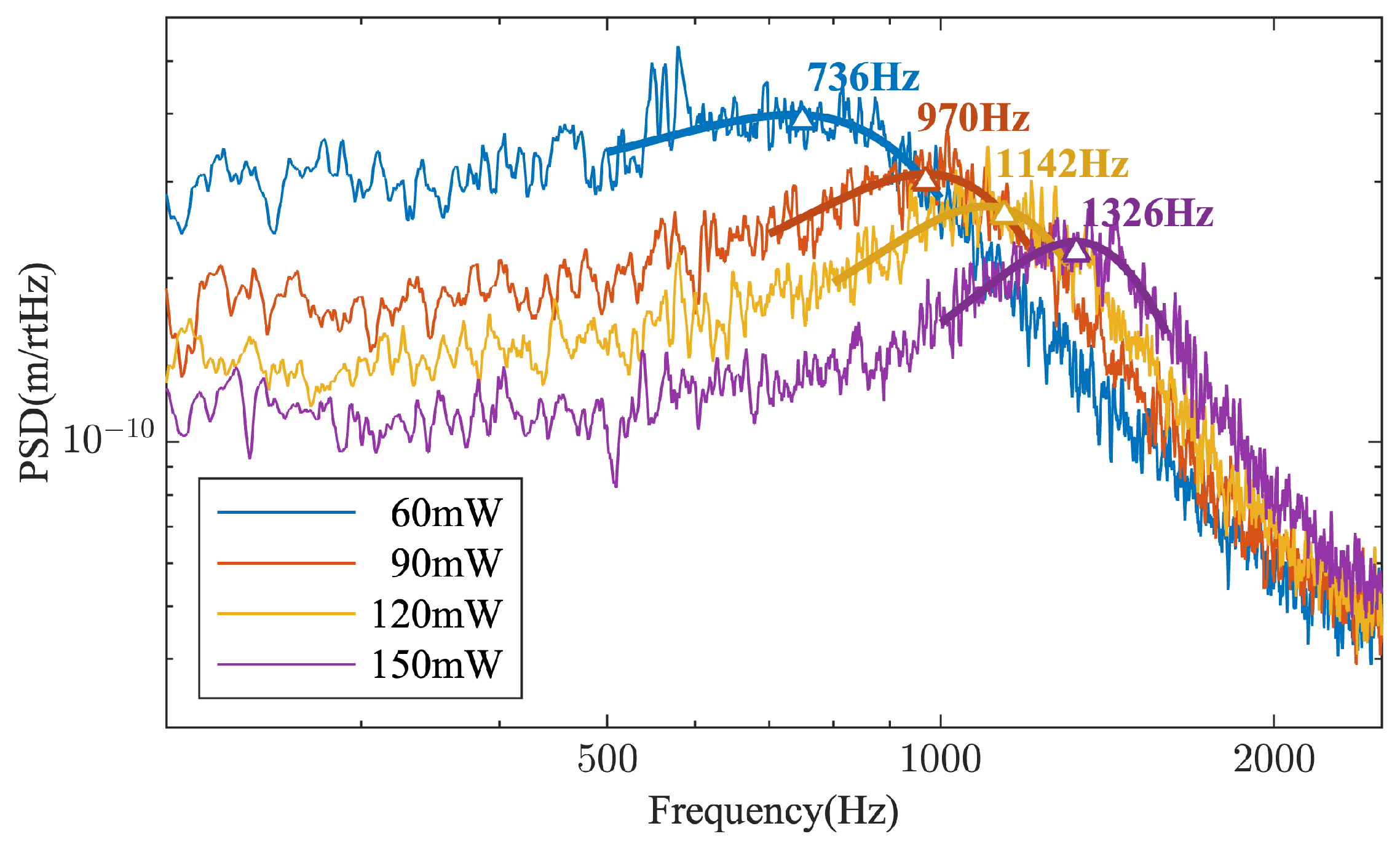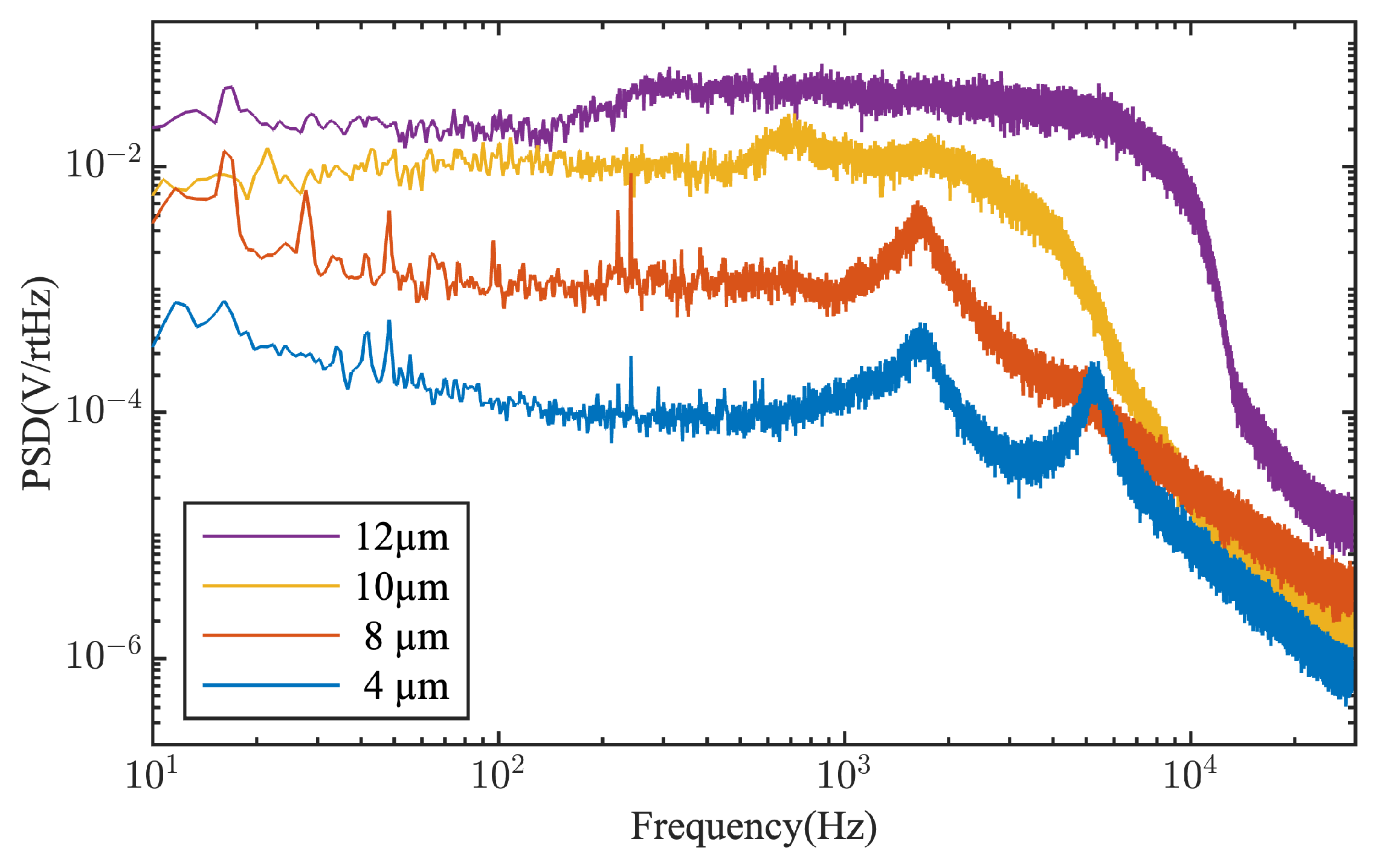Miniaturized Dual-Beam Optical Trap Based on Fiber Pigtailed Focuser
Abstract
:1. Introduction
2. Coupling Simulation
2.1. Coupling Efficiency and Alignment
2.2. Side-Scattered Light Tracking and Coupling in MMF
3. Experiment
3.1. Experimental Setup
3.2. Trapping Performance
4. Discussion
5. Conclusions
Author Contributions
Funding
Institutional Review Board Statement
Informed Consent Statement
Data Availability Statement
Conflicts of Interest
Abbreviations
| SMFPF | single-mode fiber pigtailed focuser |
| MMF | multimode fiber |
| NA | numerical aperture |
| PSD | power spectral density |
References
- Ashkin, A. Acceleration and Trapping of Particles by Radiation Pressure. Phys. Rev. Lett. 1970, 24, 156–159. [Google Scholar] [CrossRef]
- Constable, A.; Kim, J.; Mervis, J.; Zarinetchi, F.; Prentiss, M. Demonstration of a Fiber-Optical Light-Force Trap. Opt. Lett. 1993, 18, 1867. [Google Scholar] [CrossRef]
- Kim, J.D.; Lee, Y.G. Trapping of a Single DNA Molecule Using Nanoplasmonic Structures for Biosensor Applications. Biomed. Opt. Express 2014, 5, 2471. [Google Scholar] [CrossRef] [PubMed]
- Guck, J.; Ananthakrishnan, R.; Mahmood, H.; Moon, T.J.; Cunningham, C.C.; Käs, J. The Optical Stretcher: A Novel Laser Tool to Micromanipulate Cells. Biophys. J. 2001, 81, 767–784. [Google Scholar] [CrossRef]
- Chu, S.; Bjorkholm, J.E.; Ashkin, A.; Cable, A. Experimental Observation of Optically Trapped Atoms. Phys. Rev. Lett. 1986, 57, 314–317. [Google Scholar] [CrossRef] [PubMed]
- Rider, A.D.; Moore, D.C.; Blakemore, C.P.; Louis, M.; Lu, M.; Gratta, G. Search for Screened Interactions Associated with Dark Energy below the 100 μm Length Scale. Phys. Rev. Lett. 2016, 117, 101101. [Google Scholar] [CrossRef]
- Ranjit, G.; Atherton, D.P.; Stutz, J.H.; Cunningham, M.; Geraci, A.A. Attonewton Force Detection Using Microspheres in a Dual-Beam Optical Trap in High Vacuum. Phys. Rev. A 2015, 91, 051805. [Google Scholar] [CrossRef]
- Ranjit, G.; Cunningham, M.; Casey, K.; Geraci, A.A. Zeptonewton Force Sensing with Nanospheres in an Optical Lattice. Phys. Rev. A 2016, 93, 053801. [Google Scholar] [CrossRef]
- Monteiro, F.; Ghosh, S.; Fine, A.G.; Moore, D.C. Optical Levitation of 10-Ng Spheres with Nano-g Acceleration Sensitivity. Phys. Rev. A 2017, 96, 063841. [Google Scholar] [CrossRef]
- Rider, A.D.; Blakemore, C.P.; Gratta, G.; Moore, D.C. Single-Beam Dielectric-Microsphere Trapping with Optical Heterodyne Detection. Phys. Rev. A 2018, 97, 013842. [Google Scholar] [CrossRef]
- Monteiro, F.; Li, W.; Afek, G.; Li, C.l.; Mossman, M.; Moore, D.C. Force and Acceleration Sensing with Optically Levitated Nanogram Masses at Microkelvin Temperatures. Phys. Rev. A 2020, 101, 053835. [Google Scholar] [CrossRef]
- Gieseler, J.; Novotny, L.; Quidant, R. Thermal Nonlinearities in a Nanomechanical Oscillator. Nat. Phys. 2013, 9, 806–810. [Google Scholar] [CrossRef]
- Zhu, X.; Li, N.; Yang, J.; Chen, X.; Hu, H. Revolution of a Trapped Particle in Counter-Propagating Dual-Beam Optical Tweezers under Low Pressure. Opt. Express 2021, 29, 11169. [Google Scholar] [CrossRef] [PubMed]
- Li, T.; Kheifets, S.; Raizen, M.G. Millikelvin Cooling of an Optically Trapped Microsphere in Vacuum. Nat. Phys. 2011, 7, 527–530. [Google Scholar] [CrossRef]
- Otto, O.; Gutsche, C.; Kremer, F.; Keyser, U.F. Optical Tweezers with 2.5kHz Bandwidth Video Detection for Single-Colloid Electrophoresis. Rev. Sci. Instrum. 2008, 79, 023710. [Google Scholar] [CrossRef]
- Li, T.; Kheifets, S.; Medellin, D.; Raizen, M.G. Measurement of the Instantaneous Velocity of a Brownian Particle. Science 2010, 328, 1673–1675. [Google Scholar] [CrossRef] [PubMed]
- Taylor, M.A.; Bowen, W.P. A Computational Tool to Characterize Particle Tracking Measurements in Optical Tweezers. J. Opt. 2013, 15, 085701. [Google Scholar] [CrossRef]
- Xu, Z.; Song, W.; Crozier, K.B. Direct Particle Tracking Observation and Brownian Dynamics Simulations of a Single Nanoparticle Optically Trapped by a Plasmonic Nanoaperture. ACS Photonics 2018, 5, 2850–2859. [Google Scholar] [CrossRef]
- Kotnala, A.; DePaoli, D.; Gordon, R. Sensing Nanoparticles Using a Double Nanohole Optical Trap. Lab Chip 2013, 13, 4142. [Google Scholar] [CrossRef]
- Brunetti, G.; Sasanelli, N.; Armenise, M.N.; Ciminelli, C. Nanoscale Optical Trapping by Means of Dielectric Bowtie. Photonics 2022, 9, 425. [Google Scholar] [CrossRef]
- Conteduca, D.; Brunetti, G.; Pitruzzello, G.; Tragni, F.; Dholakia, K.; Krauss, T.F.; Ciminelli, C. Exploring the Limit of Multiplexed Near-Field Optical Trapping. ACS Photonics 2021, 8, 2060–2066. [Google Scholar] [CrossRef]
- Li, W.; Li, N.; Shen, Y.; Fu, Z.; Su, H.; Hu, H. Dynamic Analysis and Rotation Experiment of an Optical-Trapped Microsphere in Air. Appl. Opt. 2018, 57, 823. [Google Scholar] [CrossRef] [PubMed]
- Delabre, U.; Feld, K.; Crespo, E.; Whyte, G.; Sykes, C.; Seifert, U.; Guck, J. Deformation of Phospholipid Vesicles in an Optical Stretcher. Soft Matter 2015, 11, 6075–6088. [Google Scholar] [CrossRef] [PubMed]
- Hu, Z.; Wang, J.; Liang, J. Manipulation and Arrangement of Biological and Dielectric Particles by a Lensed Fiber Probe. Opt. Express 2004, 12, 4123. [Google Scholar] [CrossRef] [PubMed]
- Plidschun, M.; Ren, H.; Kim, J.; Förster, R.; Maier, S.A.; Schmidt, M.A. Ultrahigh Numerical Aperture Meta-Fibre for Flexible Optical Trapping. Light. Sci. Appl. 2021, 10, 57. [Google Scholar] [CrossRef]
- Xiong, W.; Xiao, G.; Han, X.; Chen, X.; Yang, K.; Luo, H. All-Fiber Interferometer for Displacement and Velocity Measurement of a Levitated Particle in Fiber-Optic Traps. Appl. Opt. 2019, 58, 2081. [Google Scholar] [CrossRef]
- Jensen-McMullin, C.; Lee, H.P.; Lyons, E.R. Demonstration of Trapping, Motion Control, Sensing and Fluorescence Detection of Polystyrene Beads in a Multi-Fiber Optical Trap. Opt. Express 2005, 13, 2634. [Google Scholar] [CrossRef]
- Kuhn, S.; Stickler, B.A.; Kosloff, A.; Patolsky, F.; Hornberger, K.; Arndt, M.; Millen, J. Optically Driven Ultra-Stable Nanomechanical Rotor. Nat. Commun. 2017, 8, 1670. [Google Scholar] [CrossRef] [PubMed]
- Cao, B.; Qiu, Z.; Huang, K.; Lü, D.; Zhang, X.; Lu, X. Single-Mode Fiber Auto-Coupling System with Wedges. Opt. Fiber Technol. 2021, 61, 102433. [Google Scholar] [CrossRef]
- Okamoto, K. Coupled Mode Theory. In Fundamentals of Optical Waveguides, 2nd ed.; Okamoto, K., Ed.; Academic Press: Burlington, MA, USA, 2006; pp. 159–207. [Google Scholar] [CrossRef]
- Doya, V.; Legrand, O.; Mortessagne, F.; Miniatura, C. Speckle Statistics in a Chaotic Multimode Fiber. Phys. Rev. E 2002, 65, 056223. [Google Scholar] [CrossRef]
- Berg-Sørensen, K.; Flyvbjerg, H. Power Spectrum Analysis for Optical Tweezers. Rev. Sci. Instrum. 2004, 75, 594–612. [Google Scholar] [CrossRef]
- Apriyanto, H.; Ravet, G.; Bernal, O.D.; Cattoen, M.; Seat, H.C.; Chavagnac, V.; Surre, F.; Sharp, J.H. Comprehensive Modeling of Multimode Fiber Sensors for Refractive Index Measurement and Experimental Validation. Sci. Rep. 2018, 8, 5912. [Google Scholar] [CrossRef] [PubMed]
- Ghatak, A.; Thyagarajan, K. An Introduction to Fiber Optics; Cambridge University Press: Cambridge, UK, 1998. [Google Scholar] [CrossRef]
- Hu, M.; Li, N.; Li, W.; Wang, X.; Hu, H. FDTD Simulation of Optical Force under Non-Ideal Conditions. Opt. Commun. 2022, 505, 127586. [Google Scholar] [CrossRef]












Disclaimer/Publisher’s Note: The statements, opinions and data contained in all publications are solely those of the individual author(s) and contributor(s) and not of MDPI and/or the editor(s). MDPI and/or the editor(s) disclaim responsibility for any injury to people or property resulting from any ideas, methods, instructions or products referred to in the content. |
© 2023 by the authors. Licensee MDPI, Basel, Switzerland. This article is an open access article distributed under the terms and conditions of the Creative Commons Attribution (CC BY) license (https://creativecommons.org/licenses/by/4.0/).
Share and Cite
Xiang, Q.; Li, N.; Chen, X.; Liu, C.; Hu, H. Miniaturized Dual-Beam Optical Trap Based on Fiber Pigtailed Focuser. Photonics 2023, 10, 1007. https://doi.org/10.3390/photonics10091007
Xiang Q, Li N, Chen X, Liu C, Hu H. Miniaturized Dual-Beam Optical Trap Based on Fiber Pigtailed Focuser. Photonics. 2023; 10(9):1007. https://doi.org/10.3390/photonics10091007
Chicago/Turabian StyleXiang, Qianyi, Nan Li, Xingfan Chen, Cheng Liu, and Huizhu Hu. 2023. "Miniaturized Dual-Beam Optical Trap Based on Fiber Pigtailed Focuser" Photonics 10, no. 9: 1007. https://doi.org/10.3390/photonics10091007
APA StyleXiang, Q., Li, N., Chen, X., Liu, C., & Hu, H. (2023). Miniaturized Dual-Beam Optical Trap Based on Fiber Pigtailed Focuser. Photonics, 10(9), 1007. https://doi.org/10.3390/photonics10091007






